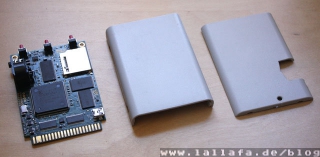So many month passed by and no update here… I wasn’t lazy (at least not all the time 😉 and so I’ll give you a short summary what retro projects I’ve been involved with lately:
- DiskFreeezerX – My pet project that aims to build a standalone disk capture device… Should come very handy for partys or meeting people that don’t want to leave their precious disks… Take the device with you, slip in a disk, press a button and some time later you have a shiny exact clone of the disk on your SD card… That’s the goal!
The current state here is: The device is built and functional as a prototype and as a first Rev A PCB… See my shiny new dfx hardware page for all the glory details and lots of photos…

- MacVICE – Not much own contribs done here lately. But always following the flow of new features and busy building current snapshots. And before I forget it: With MagerValp’s help I finally fixed the dreaded “black-screen” display problem when the fine blended display is enabled… So enjoy temporal filtering with no more black outs!
- PUAE – I am really happy that GnoStiC is now bringing together the current WinUAE and the already dated E-UAE code base to create finally a greate Amiga emualator for all *nix, Linux and Mac users… I really appreciate that and help by submitting small patches. I’ve created my own little fork/clone of the repository at GitHub: You can check this out if you want to have a look what I am patching lately: PUAE/cnvogelg
- amitools – Another little crazy project started by me. Its a python library that allows you to read and parse Amiga’s Hunk-based binary format. With all the memory on the good ol’ times fading away and with UAE refreshing my old desire for the Amiga I wrote this lib to refresh and to store the old knowledge in readable python code. Currently, there is not much docs there. But a real hacker will find his/her way… I wrote a small sample that scans your harddrive for amiga files (even in adf, lha containers) and tries to parse the exe with the lib… The lib got a new push with the introduction of the AROS m68k Port (yay!!).. This port uses a decent gcc compiler to generate m68k-elf binaries. So I added ELF parsing to amitools. The only thing still missing is now the converter elf to hunk and back again in python (similar to elf2hunk)…
That’s it! See you soon with more updates…







